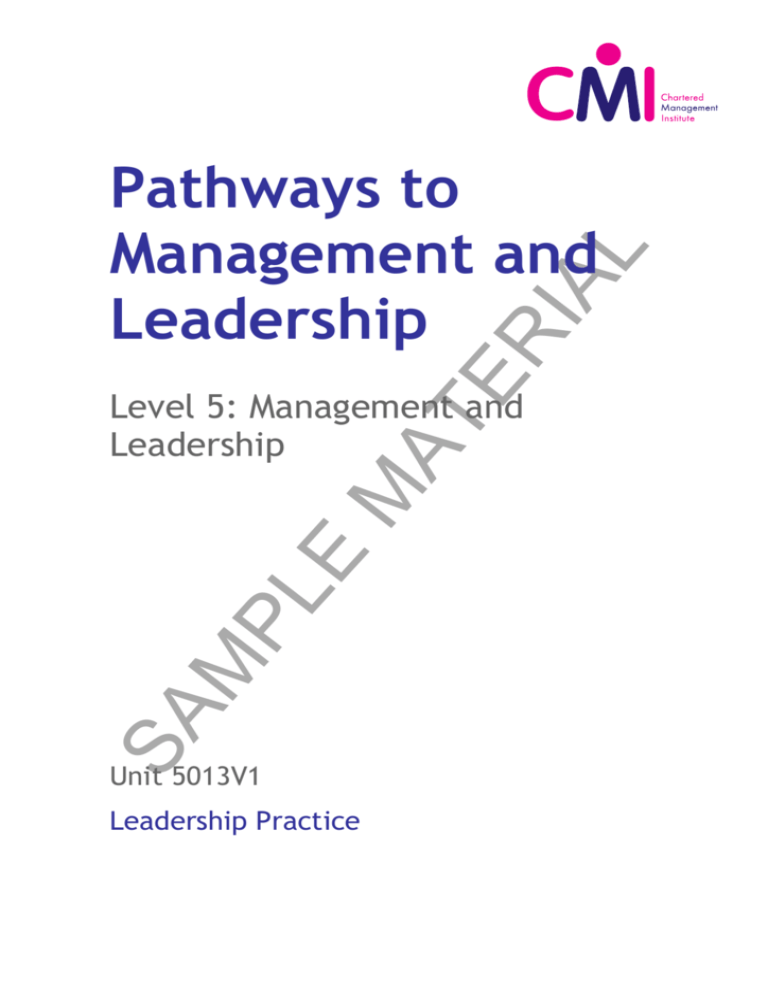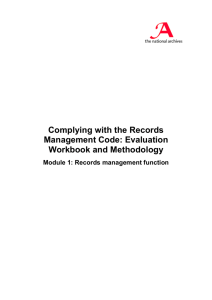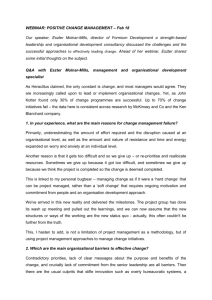
ER
I
AL
Pathways to
Management and
Leadership
SA
M
PL
E
M
AT
Level 5: Management and
Leadership
Unit 5013V1
Leadership Practice
Pathways to Management and Leadership
Unit 5013V1: Leadership Practice
Copyright © Chartered Management Institute, Management House, Cottingham Road, Corby,
Northants NN17 1TT.
Revised July 2013
Ian Favell
Ray Rowlings
ER
I
Revised edition 2010
Author:
Consultant:
Ian Favell
Roger Merritt Associates
Bob Croson
Trevor Weston
Suzanne Pattinson
Decent Typesetting
AT
Author:
Series consultants:
Consultant:
Project manager:
Editor:
Page layout by:
AL
First edition 2009
ISBN 0-85946-542-X
M
British Library Cataloguing-in-Publication Data. A CIP catalogue record for this publication is available from
the British Library.
M
PL
E
All rights reserved, save as set out below. No part of this publication may be reproduced, stored in a
retrieval system, or transmitted in any form or by any means, electronic, mechanical, photocopying,
recording or otherwise, without the written permission of the copyright holder except in accordance with
the provisions of the Copyright, Designs and Patents Act 1988 or under the terms of a licence issued by the
Copyright Licensing Agency Ltd, 90 Tottenham Court Road, London, England WIT 4LP.
Applications for the copyright holder’s written permission to reproduce any part of this publication should
be addressed to the publisher. Permissions may be sought directly from the Chartered Management
Institute in Corby, UK. Phone Publications on (+44) (0) 1536 207379, or email
publications@managers.org.uk.
This publication is sold subject to the condition that it shall not, by way of trade or otherwise, be lent, resold, hired out, or otherwise circulated without the publisher’s prior consent in any form of binding or
cover other than that in which it is published and without a similar condition being imposed on the
subsequent purchaser.
SA
Approved centres may purchase a licence from the publisher, enabling PDF files of the publication to be
printed or otherwise distributed solely within the centre for teacher and student use only according to the
terms and conditions of the licence.
Further information on the licence is available from the Chartered Management Institute.
Phone (+44) (0) 1536 207379, or email publications@managers.org.uk.
Every effort has been made to trace holders of copyright material reproduced here. In cases where this has
been unsuccessful or if any have inadvertently been overlooked, the publishers will be pleased to address
this at the first opportunity.
SA
M
PL
E
M
AT
ER
I
AL
Leadership Practice
SA
M
PL
E
AT
M
AL
ER
I
Contents
About this workbook .................................................. 7 The unit .................................................................................. 7 The aims of this workbook ............................................................ 7 Syllabus coverage....................................................................... 8 AL
Getting started ......................................................................... 8 How to use the workbooks ............................................................ 8 Leaders and managers ................................ 11 ER
I
Section 1 What are leadership and management? ............................................ 11 Leadership and management activities ............................................ 17 Section 2 AT
Summary ................................................................................ 26 The quality of leadership............................. 27 Leadership and relationships with others ......................................... 27 M
Leaders and their own development ............................................... 34 Summary ................................................................................ 36 Leadership styles ...................................... 37 M
PL
E
Section 3 Types of leadership ................................................................... 37 Summary ................................................................................ 49 Before you move on .................................................. 51 Preparing for assessment ............................................................. 51 Reflecting on progress ................................................................ 52 SA
Planning your next steps ............................................................. 52 The Management and Leadership Standards ...................................... 53 How this workbook relates to the standards ...................................... 53 Bibliography ............................................................ 55 Websites ................................................................................ 57 SA
M
PL
E
AT
M
AL
ER
I
About this workbook
The unit
The main purpose of this workbook is to support you as you study
for the Chartered Management Institute Level 5 in Management
and Leadership qualifications. Specifically it focuses on the
content relevant to Unit 5013V1 Leadership Practice.
ER
I
AL
This workbook provides underpinning knowledge and develops
understanding to improve your skills as well as to prepare you for
future assessment. If you are studying for the Level 5 in
Management and Leadership qualifications, then you will be
assessed by your approved centre on ‘your knowledge and
understanding of’ the following learning outcomes.
1. Understand the links and differences between leadership and
management
2. Understand leadership principles that support organisational
values
M
AT
3. Understand and apply leadership styles to achieve
organisational objectives
The aims of this workbook
This workbook aims to help you learn how to:
M
PL
E
distinguish between management and leadership activities
support organisational values by leading effectively
SA
use leadership skills effectively to achieve organisational
objectives.
7
About this workbook
Leadership Practice
Syllabus coverage
The table below shows which sections of the workbook address
each of the assessment criteria of the qualification syllabus.
Addressed
within
section:
Unit 5013V1 syllabus coverage
Leadership Practice
1
1.2 Discuss the concept of leaders as effective
managers
1
1.3 Evaluate the balance needed between the
demands of management and the demands of
leadership
1
2.1 Analyse the role of the leader in contributing to
the creation of the organisation’s vision and in
its communication to others
2
2.2 Evaluate how personal energy, self-belief and
commitment impact on leadership styles
2
2.3 Evaluate how empowerment and trust through
ethical leadership impacts on organisational
practice
2
3.1 Distinguish between two different leadership
styles
3
3.2 Evaluate the practical value of a leadership style
to a manager in achieving organisational
objectives
3
3.3 Interpret how situational variables influence the
choice of leadership style
3
M
PL
E
M
AT
ER
I
AL
1.1 Discuss the concept of managers as effective
leaders
SA
Getting started
People are the most valuable resource of any organisation.
Making sure that people with the right skills and knowledge are
in place at the right time, that they know what’s expected of
them and how well they are doing, and that they are being led in
an appropriate manner is key to success.
This workbook begins by exploring organisational culture and
structure and its effect on leadership. It then moves on to
considering some aspects of leadership styles, and how these
might affect the achievement of organisational objectives.
How to use the workbooks
The workbooks provide ideas from writers and thinkers in the
management and leadership field. They offer opportunities for
8
Leadership Practice
About this workbook
you to investigate and apply these ideas within your working
environment and job role.
Structure
ER
I
AL
Each workbook is divided into sections that together cover the
knowledge and understanding required for that unit of the
Chartered Management Institute Level 5 in Management and
Leadership. Each section starts with a clear set of objectives that
identify the background knowledge to be covered, and the
management skills in the workplace that enable you to
demonstrate this knowledge. You don’t have to complete the
sections in the order they appear in the workbook, but you
should try to cover them all to make sure that your work on the
unit is complete. There are self-assessment questions at the end
of each section that allow you to check your progress. You may
want to discuss your answers to these questions with your line
manager or a colleague.
Activities
AT
Throughout the workbooks there are activities for you to
complete. These activities are designed to help you to develop
yourself as a manager. Space is provided within the activities for
you to enter your own thoughts or findings. Feedback is then
provided to confirm your input or to offer more ideas for you to
consider.
M
PL
E
M
To get the best from the workbooks, you should try to complete
each activity fully before moving on. However, if the answer is
obvious to you because the issue is one you have encountered
previously, then you might just note some bullet points that you
can then compare quickly against the feedback. You may
sometimes find it difficult to write your complete response to an
activity in the space provided. Don’t worry about this — just
keep a separate notebook handy, which you can use and refer to
as needed.
Try not to look at the feedback section before completing an
activity. You might like to cover up the feedback with a postcard
or piece of paper while you’re working through an activity.
SA
Timings
Timings are suggested for each section and activity, although it is
important that you decide how much time to spend on an
activity. Some activities may occupy only a few moments’
thought, while others may be of particular interest and so you
might decide to spend half an hour or more exploring the issues.
This is fine — the purpose of the activities is to help you reflect
on what you are doing, and to help you identify ways of
enhancing your effectiveness. It is always worth writing
something though, even if it’s brief — the act of writing will
reinforce your learning much more effectively than just referring
to the feedback.
9
About this workbook
Leadership Practice
Scenarios
There are scenarios and examples throughout each workbook to
illustrate key points in real workplace settings. The scenarios
cover a wide range of employment sectors. As you work through,
you might like to think of similar examples from your own
experience.
Planning your work
ER
I
AL
The reading and reflection, scenarios and activities in each
section of the workbooks are designed to take around two hours
to complete (although some may take longer). This is a useful
indicator of the minimum length of time that you should aim to
set aside for a study session. Try to find a quiet place where you
will not be interrupted and where you can keep your workbooks,
notes and papers reasonably tidy. You may also like to think
about the time of day when you work best — are you a ‘morning
person’ who likes to get things done at the start of the day, or do
you work better in the evening when there may be fewer
disturbances?
AT
Preparing for assessment
M
Further information on assessment is available in the Student
Guide produced as part of the Pathways to Management and
Leadership series. If you have any further questions about
assessment procedures, it is important that you resolve these
with your tutor or centre co-ordinator as soon as possible.
Further reading
SA
M
PL
E
Suggestions for further reading and links to management
information are available via ManagementDirect through the
Study Support section of the Institute's website at
http://mde.managers.org.uk/members. Alternatively, email
ask@managers.org.uk or telephone 01536 207400. You will also
find titles for further reading in the Bibliography at the end of
this workbook.
10
Section 1 Leaders and managers
Time required: about 1½ hours
Learning outcome
By the end of this section you will understand the links and
differences between management and leadership and be able to:
AL
1.1 Discuss the concept of managers as effective leaders
1.2 Discuss the concept of leaders as effective managers
ER
I
1.3 Evaluate the balance needed between the demands of
management and the demands of leadership
What are leadership and management?
Activity
Activity 1.1
AT
There is much debate in the literature for leadership and for
management about the extent to which these are two different
roles, two aspects of the same role, or only one role with two
different titles.
(about 5 minutes)
What is your opinion?
M
Is management the same thing as leadership?
SA
M
PL
E
Make some notes here.
Feedback
You probably responded that they can be the same person or
job role, but there are different characteristics for each that
you can use to define them, which makes them not exactly the
same — although of course some aspects may overlap or be in
common to both management and leadership.
11
Section 1 Leaders and managers
Leadership Practice
Many writers comment on the similarities and differences
between managers and leaders. One example is Colenso (1997),
who summarises the differences in a table.
Management
Addresses ‘why’
Addresses ‘how’
Inspiration
Clarification
Service focus
Profit focus
Strategy
Operations
Innovation
Improvement
Fulfilment
Performance
Versatility
Consistency
ER
I
AL
Leadership
Alignment
Accountability
Fig 1: Leader—manager balance
AT
If you examine these categories carefully you should see that
leadership appears to be much more about involving people and
motivational aspects, whereas management seems to be more
organisational output and task focused. This sort of
differentiation is also captured by Dixon (1993) who states:
M
‘Leadership is the ability to influence the attitudes and
behaviours of others. Management is the formal
process of decision and command.’
M
PL
E
If management is associated with decisions and control,
managers are likely to be mostly engaged in work that focuses
upon the systems, process and tasks required to meet
organisational goals. Drucker (1973) confirmed this approach,
with his definition of a manager’s work as falling into five basic
operations:
setting objectives
organising
motivating and communicating
SA
measuring
developing people, including themselves.
He then identified the following as management tasks:
defining the business mission
setting standards
building and maintaining the organisation
developing and maintaining external relationships
performing social and civic functions
12
Leadership Practice
Section 1 Leaders and managers
knowing how to get on with the task in hand if and when
necessary.
You can read more about Drucker’s ideas in the study resource
area of the CMI website.
Activity
Activity 1.2
(about 5 minutes)
Given that managers appear to have a work-output focus, to
what extent do managers actually lead?
You probably responded that the realisation of work goals is a
necessary focus in organisational life, but that leadership is
needed to achieve this by:
AT
Feedback
ER
I
AL
Make some notes here.
defining and clarifying the goals
M
devising and sharing a plan to identify where, when and how
the goals are to be achieved
ensuring that everyone is clear about exactly what’s to be
achieved by them individually and by when
M
PL
E
providing essential task and skills training and development
to ensure everyone is appropriately equipped to deliver the
plan
demonstrating to everyone the drive and commitment
necessary to achieve the plan
SA
monitoring and feeding back to everyone on progress against
the plan.
Back in 1955 Drucker identified that there is no substitute for
leadership, but he said that management can’t create leaders.
Managers can only create the conditions for leadership qualities
in others to become effective; otherwise management can stifle
potential.
In The One Minute Manager (Blanchard and Johnson, 1983) a
young manager wishes to become truly effective, but finds they
are caught between two extremes of the scientific and human
relations schools of thought. Some managers get good results but
at a price that few colleagues and subordinates seem willing to
support, while other managers (whose people really like them)
have results which leave much to be desired.
13
Section 1 Leaders and managers
Leadership Practice
There’s a ‘Thinker’ about this book and its authors in the study
resources section of the CMI website, which you might like to
read at this point.
A report by Towers Perrin (2005) highlights that although many
people would like to contribute more, the behaviour of their
managers actively discourages them from doing so. Clearly then,
one of a manager’s roles is to take a lead in providing the
conditions to foster greater leadership activity in others.
Activity 1.3
(about 5 minutes)
AL
Activity
What sorts of things would a manager need to focus upon to
build and increase leadership in an organisation?
M
PL
E
M
AT
ER
I
Make some notes here.
SA
Feedback
There’s no single answer to this question, which is mainly
addressing the organisational issues usually referred to as
organisational culture. You will probably have listed some of
the following ideas (these are taken from Schein, 1997):
the behaviours used by managers and staff
the daily norms within working groups
the dominant values pushed by the organisation and the
managers
the philosophy guiding the attitudes of senior management
to staff and customers
the organisational rules, procedures and processes
the unspoken feelings and climate of the workplace.
14
Leadership Practice
Section 1 Leaders and managers
You may also have included some practical items that can affect
the climate such as:
what people wear (or are expected to wear)
the layout of the workplace
the quality and appropriateness of the physical items
(desks, chairs, equipment, machinery)
AL
how attendance and timekeeping is monitored (clocking in,
signing in, freedom to come and go as required).
M
AT
ER
I
In 2004 Schein highlighted that what is important for managers
who wish to encourage leadership is the alignment between the
espoused beliefs and values within the organisation or the team
and the underlying assumptions. In other words, the
organisation or team might give lip service to a climate and
behaviours that are good, but this isn’t what happens in
practice. Or the reality and the intentions are actually in
alignment. The greater the coherence between these two
aspects, the more likely it is that the organisational culture will
facilitate leadership. The further apart these two aspects of
culture are, the more dysfunctional an organisation may be in
achieving its goals. The role of the effective manager and
leader is to provide the environment, help and support to
enable this essential alignment.
M
PL
E
In the student resource area of the CMI website for this unit
there’s a checklist entitled Understanding Organisational
Culture, which might be useful additional reading at this point.
You might also read the ‘Thinkers’ about Charles Handy and
Schein who have written much about organisational culture.
Aspects of leadership
SA
While it’s clear that managers do to some extent lead —
especially in the setting and realisation of organisational
systems, processes and goals, Barsh, Capozzi and Davidson (2008)
warn of the following:
‘Tinkering with organisational structures and processes
as a way of stimulating creativity and innovation, and
using questionable ‘best practices’ does not get results.
What really makes the difference is Leadership’.
The idea that leadership is much more about people and
motivation has continued to grow, and most recent researchers
and writers confirm this. Alimo-Metcalfe and Alban-Metcalfe
(2008) wrote the following:
‘The need for leadership is critical in order for
organisations to sustain and increase their
effectiveness.’
15
Section 1 Leaders and managers
Activity
Leadership Practice
Activity 1.4
(about 10 minutes)
Given the ideas so far in this section, what are some of the key
aspects of leadership?
Feedback
ER
I
AL
Make some notes here.
In her article ‘The 21st century leader’, Turnbull (2008a) draws
attention to the results from a study that highlights important
aspects of leadership in the modern world. These include:
a focus upon the longer-term good for all
AT
responding effectively to the increasing pace of change
the need for full engagement by followers
M
generating and sharing a common vision of the future that
combines inspiration with action
the need for ‘good’ and ‘ethical’ behaviours, best expressed
to fit our global multicultural society as integrity, humility,
and wisdom
M
PL
E
authenticity in being true to yourself, rather than acting or
playing a predetermined part or role
being trusted to deliver on promises and not let people
down
facilitating your own and others’ growth and achievement
SA
honest feedback and appraisal.
You should have identified many of these types of issues in your
response.
Trust is key and is often the foundation for the growth of these
other behavioural characteristics suggested by Turnbull (2008a).
Increasingly, researchers are also highlighting the importance of
leaders actively encouraging creativity and innovation.
Jackson (2004), for example, highlights that the role of the
leader is to liberate, harness and focus the potential of
employees for the benefit of the individual and the organisation.
Gill (2008a) says that:
‘It is leadership that enables creativity and innovation
…’
16
Leadership Practice
Section 1 Leaders and managers
and this is supported by Turnbull (2008b) who confirms that:
‘Leadership stimulates creativity and innovation for the
purposes of sustaining the health of the organisation …’
You should notice here that these attributes of professional and
effective modern leaders are all behavioural and rely on strong
relationships.
ER
I
AL
What is required of modern leaders is therefore more about how
they do things and who they are as authentic individuals, rather
than the actual tasks that they are achieving. The achievement
of organisational goals is important, but Turnbull’s findings
reinforce the relationship and behavioural side of leadership.
This is entirely consistent and coherent with ideas suggested by
other modern writers, as well as much earlier writers such as
Adair (1983 and 1987), with his emphasis on the group and the
individual as well as the task. This theme is explored in more
detail in Sections 2 and 3 of this workbook.
Activity
Activity 1.5
AT
Leadership and management activities
(about 10 minutes)
M
If, as the writers mentioned above believe, a leader’s main role
is to provide support for innovation and creativity, to what
extent does a leader undertake activities that are usually
described as those of management?
SA
M
PL
E
Make some notes here.
17
Section 1 Leaders and managers
Feedback
Leadership Practice
Referring back to the ideas of Drucker (1973) and Dixon (1993),
leaders do in fact have some management functions, and you
probably mentioned some of the following:
agreeing objectives and the means of their achievement
motivating and communicating
developing people, including themselves
developing and maintaining relationships
AL
monitoring progress towards the goal.
Scenario
ER
I
This gives some idea of the potential overlap between
leadership and management. Both have to keep an eye on the
goal and progress towards it and both need to ensure that the
staff are motivated and focused to be able to contribute
appropriately.
Scenario 1
AT
Exhibitions for All is a national company providing the
infrastructure for major trade exhibitions in the UK. John is the
manager of the department that project manages the exhibition
stand side of the business.
SA
M
PL
E
M
At present his department is focusing on five main projects, one
on the south coast, two in the Midlands and one in Scotland. The
location for the fifth is still not clear, and John is having to
spend a large amount of time on the logistics of providing stands
to an unknown location, especially since, with four other
projects on the go, all the company stands will be in use but will
need to be transported to the unknown location.
18
John has always taken a very task-focused approach to the job,
and his team members (seven of them) are used to this. He tells
them what to do and they do what he has asked them to. There’s
a problem now though, in that John can’t issue the normal
detailed instructions for the fifth project. Unless this is done
soon, the team won’t have enough time to make the necessary
arrangements for the transfer, let alone the staffing and rigging
of the stands when they arrive.
His team are beginning to complain about the looming pressure
they will be placed under. One of them, Zapphi, has come up
with a suggestion that she thinks might enable some of the
planning to be done without knowing the location. She
approached John with her idea, but as it didn’t fit in with the
usual way of working and had a small element of risk about it
(some of the work might be wasted and would need to be redone
with some of the potential locations), John rejected the idea
outright. Zapphi wasn’t daunted though and explained her idea
to the rest of the team. Although John had declared that
everyone would have to wait until the location was known, and
then work long hours to catch up on the time lost, the other










